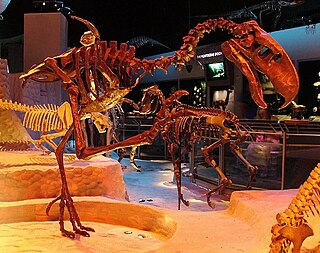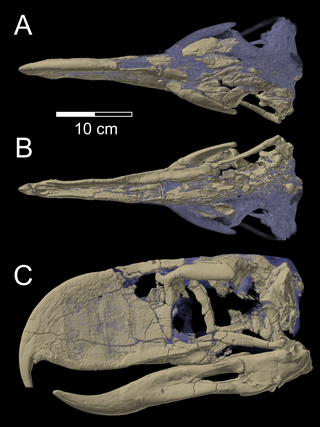
Phorusrhacids, colloquially known as terror birds, are an extinct family of large carnivorous, mostly flightless birds that were among the largest apex predators in South America during the Cenozoic era. Their definitive fossil records range from the Middle Eocene to the Late Pleistocene around 43 to 0.1 million years ago, though some specimens suggest that they were present since the Early Eocene.

Andalgalornis is a genus of flightless predatory birds of the extinct family Phorusrhacidae that lived in Argentina. The type and only species is A. steulleti.

Brontornis is an extinct genus of giant bird that inhabited Argentina during the Early to Middle Miocene. Its taxonomic position is highly controversial, with authors alternatively considering it to be a cariamiform, typically a phorusrhacid or an anserimorph.

Strigogyps is an extinct genus of prehistoric bird from the Middle Eocene to Early Oligocene of France and Germany. It was probably around the size of a large chicken or a guan, weighing not quite 1 kilogram (2.2 lb). Apparently, as indicated by the ratio of lengths of wing to leg bones, S. sapea was flightless. Its legs were not adapted to running, so it seems to have had a walking lifestyle similar to trumpeters. Unlike other Cariamiformes which appear to have been mostly carnivorous, the specimens of one species, Strigogyps sapea, suggest a facultatively herbivorous or omnivorous diet.

Notosuchus is an extinct genus of South American notosuchian crocodyliforms. It was terrestrial, living approximately 85 million years ago in the Santonian stage of the Late Cretaceous.

Cramauchenia is an extinct genus of litoptern South American ungulate. Cramauchenia was named by Florentino Ameghino. The name has no literal translation. Instead, it is an anagram of the name of a related genus Macrauchenia. This genus was initially discovered in the Sarmiento Formation in the Chubut Province, in Argentina, and later it was found in the Chichinales Formation in the Río Negro Province and the Cerro Bandera Formation in Neuquén, also in Argentina, in sediments assigned to the SALMA Colhuehuapian, as well as the Agua de la Piedra Formation in Mendoza, in sediments dated to the Deseadan. In 1981 Soria made C. insolita a junior synonym of C. normalis. A specimen of C. normalis was described in 2010 from Cabeza Blanca in the Sarmiento Formation, in sediments assigned to the Deseadan SALMA.
Purranisaurus is an extinct genus of marine crocodyliform from the Middle to Late Jurassic period of Chile and Vaca Muerta of Argentina. Rusconi originally regarded Purranisaurus potens to be a plesiosaur; however, Gasparini demonstrated that it was in fact a metriorhynchid crocodyliform, and that may be a junior synonym of Metriorhynchus. It was about 3.3 m (11 ft) long.
Paleontology or palaeontology is the study of prehistoric life forms on Earth through the examination of plant and animal fossils. This includes the study of body fossils, tracks (ichnites), burrows, cast-off parts, fossilised feces (coprolites), palynomorphs and chemical residues. Because humans have encountered fossils for millennia, paleontology has a long history both before and after becoming formalized as a science. This article records significant discoveries and events related to paleontology that occurred or were published in the year 1968.

Notosuchia is a suborder of primarily Gondwanan mesoeucrocodylian crocodylomorphs that lived during the Jurassic and Cretaceous. Some phylogenies recover Sebecosuchia as a clade within Notosuchia, others as a sister group ; if Sebecosuchia is included within Notosuchia its existence is pushed into the Middle Miocene, about 11 million years ago. Fossils have been found from South America, Africa, Asia, and Europe. Notosuchia was a clade of terrestrial crocodilians that evolved a range of feeding behaviours, including herbivory (Chimaerasuchus), omnivory (Simosuchus), and terrestrial hypercarnivory (Baurusuchus). It included many members with highly derived traits unusual for crocodylomorphs, including mammal-like teeth, flexible bands of shield-like body armor similar to those of armadillos (Armadillosuchus), and possibly fleshy cheeks and pig-like snouts (Notosuchus). The suborder was first named in 1971 by Zulma Gasparini and has since undergone many phylogenetic revisions.

Devincenzia is an extinct genus of giant flightless predatory birds in the family Phorusrhacidae or "terror birds" that lived during the Early Miocene (Deseadan) Fray Bentos Formation of Uruguay, Late Miocene (Huayquerian) Ituzaingó Formation, Early Pliocene (Montehermosan) of Argentina, and possibly the Early Pleistocene Raigón Formation of Uruguay. The type species D. pozzi was formerly known as Onactornis pozzi. The largest possible specimen weighed up to 350 kilograms (770 lb), making it one of the largest phorusrhacids and carnivorous birds known.

Psilopterus is an extinct genus of phorusrhacid from the Middle Oligocene to possibly the Late Pleistocene of Argentina and Uruguay. Compared to other phorusrhacids, members of the genus are both relatively gracile and diminutive, and include the smallest known species of terror bird: with the head raised P. bachmanni was 70–80 centimeters (2.3–2.6 ft) in height and weighed about 5 kilograms (11 lb), while the largest members of the genus were only about 8 kilograms (18 lb). The birds resemble the modern cariama, except with a heavier build and considerably smaller wings. Fossil finds in Uruguay indicate the genus may have survived until 96,040 ± 6,300 years ago, millions of years after the larger phorusrhacids became extinct.

Baurusuchidae is a Gondwanan family of mesoeucrocodylians that lived during the Late Cretaceous. It is a group of terrestrial hypercarnivorous crocodilians from South America and possibly Pakistan. Baurusuchidae has been, in accordance with the PhyloCode, officially defined as the least inclusive clade containing Cynodontosuchus rothi, Pissarrachampsa sera, and Baurusuchus pachecoi. Baurusuchids have been placed in the suborder Baurusuchia, and two subfamilies have been proposed: Baurusuchinae and Pissarrachampsinae.

Araripesuchus is a genus of extinct crocodyliform that existed during the Cretaceous period of the late Mesozoic era some 125 to 66 million years ago. Araripesuchus is generally considered to be a notosuchian, characterized by the varied teeth types and distinct skull elements. Seven species have been referred to Araripesuchus, though it has been argued that the phylogenetic position of this genus is uncertain, and that taxonomic revision is required.
The Santacrucian age is a period of geologic time within the Early Miocene epoch of the Neogene, used more specifically with SALMA classification in South America. It follows the Colhuehuapian and precedes the Friasian age.
Ilchunaia is an extinct genus of sebecid mesoeucrocodylian. Fossils have been found from the Divisadero Largo Formation of Argentina dating back to the Late Eocene, and a locality in Mendoza, Argentina dating back to the Oligocene. Little material is known from the genus, with only the anterior portion of the skull being present to study.

Cariamiformes is an order of primarily flightless birds that has existed for over 50 million years. The group includes the family Cariamidae (seriemas) and the extinct families such as Phorusrhacidae, Bathornithidae, Idiornithidae and Ameghinornithidae. Extant members (seriemas) are only known from South America, but fossils of many extinct taxa are also found in other continents including Europe and North America. Though traditionally considered a suborder within Gruiformes, both morphological and genetic studies show that it belongs to a separate group of birds, Australaves, whose other living members are Falconidae, Psittaciformes and Passeriformes.

Bathornithidae is an extinct family of birds from the Eocene to Miocene of North America. Part of Cariamiformes, they are related to the still extant seriemas and the extinct Phorusrhacidae. They were likely similar in habits, being terrestrial, long-legged predators, some of which attained massive sizes.

Bathornis is an extinct lineage of birds related to modern day seriemas, that lived in North America about 37–20 million years ago. Like the closely related and also extinct phorusrhacids, it was a flightless predator, occupying predatory niches in environments classically considered to be dominated by mammals. It was a highly diverse and successful genus, spanning a large number of species that occurred from the Priabonian Eocene to the Burdigalian Miocene epochs.
The Agua de la Piedra Formation is a Late Oligocene geologic formation of the Malargüe Group that crops out in the southernmost Precordillera and northernmost Neuquén Basin in southern Mendoza Province, Argentina.
Proadinotherium is an extinct genus of toxodontid. It lived between the Late Oligocene and the Early Miocene in what is now South America.












